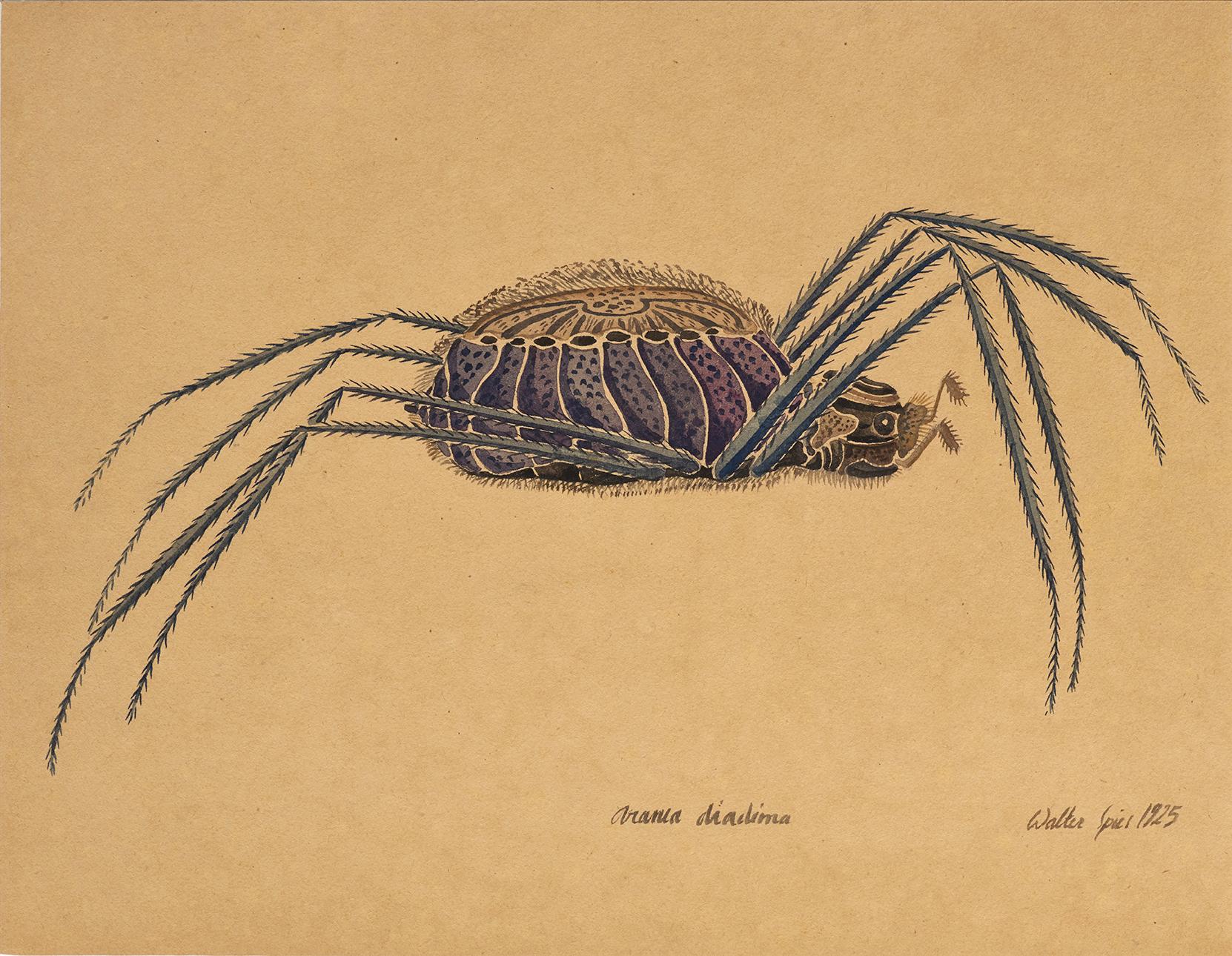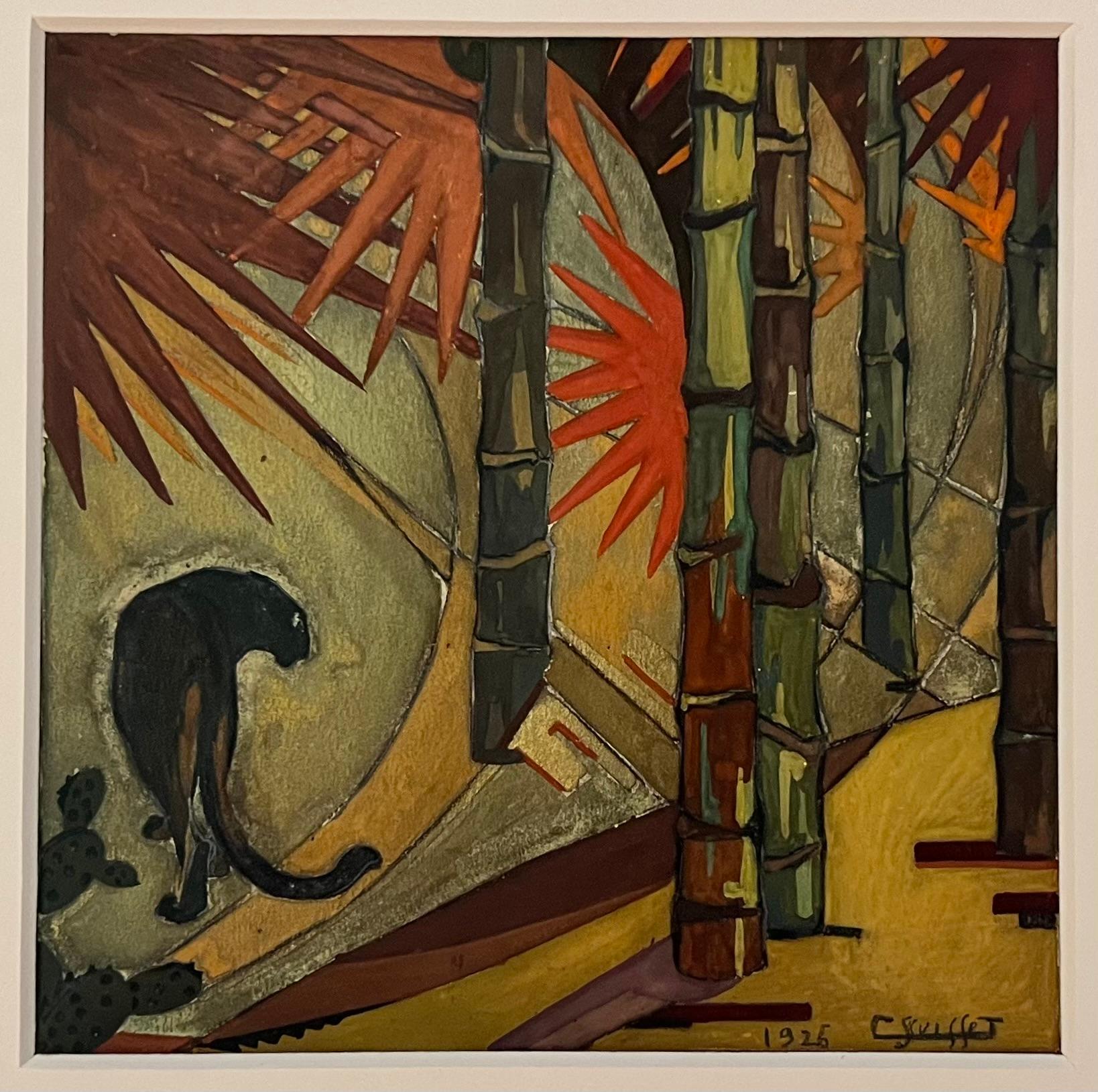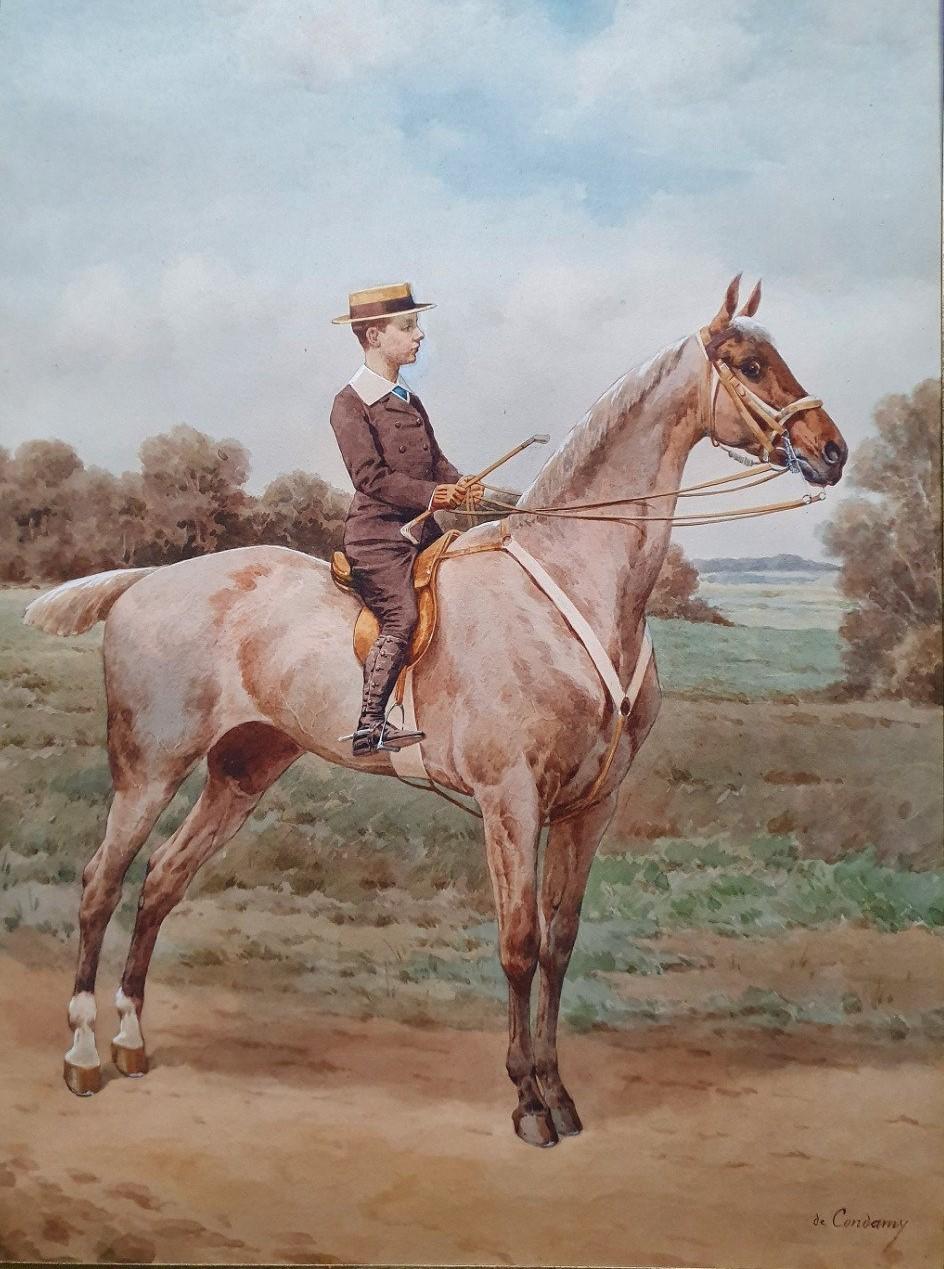Items Similar to Attributed to Francesco Casanova (1727-1803), A Mamluk fighting , watercolor
Want more images or videos?
Request additional images or videos from the seller
1 of 16
Attributed to Francesco Casanova (1727-1803), A Mamluk fighting , watercolorcirca 1799
circa 1799
About the Item
Attributed to Francesco Casanova (1727-1803),
A Mamluk fighting on his horse,
watercolor and ink on paper
35 x 26 cm
In quite good condition : yellowed by time as visible on the photographs.
Vintage frame with little damages (see photographs please), the mat and the back have been recently changed. 54 x 44 cm
The first indication about attribution was given by the name indicated on the vintage frame with what could look as a mistake about the date of death of the artist, if the exact date of Francesco Casanova'death was not known with certainty. It's estimated he died at the beginning of the 19th century, Maybe in 1803, 1805 or as late as 1807.
The style and execution are really close to the artist's known compositions, the way he draws the horse for example.
Francesco Giuseppe Casanova was an Italian painter who specialised in battle scenes. His older brother was Giacomo Casanova, the famous adventurer, and his younger brother was Giovanni Casanova; also a well-known painter.
He was born in London, and returned to Venice when he was still young,upon his brother Giovanni's advice, he went to Paris and became an apprentice of Charles Parrocel.
As a result of favourable criticism from Denis Diderot, he began to receive commissions from the aristocracy. His fame soon spread eastward and he received commissions from Catherine the Great for the Hermitage, beginning in 1768. Two years later, he produced his four famous "disaster paintings", which were purchased by Jean-Benjamin de la Borde on behalf of King Louis XV.
Despite his success and his many aristocratic clients, he squandered his money, was perpetually in debt, and died in poverty at his home near Mödling. The year is generally given as 1803, although some sources have 1805 or 1807.
The subject is also very interesting: this watercolor depicts a Mamluk, a term most commonly referring to non-Arab slave-soldiers and freed slaves to which were assigned military and administrative duties, serving the ruling Arab dynasties in the Muslim world.
They are better known to have fought against Napoleon Bonaparte in Egypt, approximately at the time this artwork was painted. Napoleon later formed his own Mamluk corps, the last known Mamluk force, in the early years of the 19th century, and used Mamluks in a number of his campaigns. Napoleon's famous bodyguard Roustam Raza was also a Mamluk who had been sold in Egypt.
We can easily recognize the oriental uniform of the cavalier with his characterisitic hat.
- Attributed to:Francesco Giuseppe Casanova (1727 - 1802, Italian)
- Creation Year:circa 1799
- Dimensions:Height: 13.78 in (35 cm)Width: 10.24 in (26 cm)
- Medium:
- Period:1790-1799
- Condition:
- Gallery Location:Paris, FR
- Reference Number:
About the Seller
5.0
Platinum Seller
These expertly vetted sellers are 1stDibs' most experienced sellers and are rated highest by our customers.
Established in 2018
1stDibs seller since 2019
210 sales on 1stDibs
Typical response time: <1 hour
- ShippingRetrieving quote...Ships From: Paris, France
- Return PolicyA return for this item may be initiated within 14 days of delivery.
More From This SellerView All
- Attributed to Eugène Lami (1800-1890) A Maid feeding rabbits, WatercolorBy Eugène Louis LamiLocated in Paris, FRAttributed to Eugène Lami (1800-1890) A maid feeding rabbits Watercolor on paper Bears a monogramm E L on the lower right 12.5 x 12.5 cm In good condition, some foxings in the uppe...Category
1860s Academic Figurative Drawings and Watercolors
MaterialsWatercolor
- Gustave Fraipont (1849-1923) A peasant girl with her flock of Turkeys, drawingBy Gustave FraipontLocated in Paris, FRGustave Fraipont (1849-1923) A Peasant girl with her flock of Turkeys, Ink and heightenings of blue watercolor on paper 23 x 15 cm Signed on the lower left and titled on lower righ...Category
1890s Realist Animal Drawings and Watercolors
MaterialsIndia Ink, Watercolor
- Henri-Louis Dupray (1841-1909) Studies of military horsemen, two signed drawingsBy Henry Louis DuprayLocated in Paris, FRHenri-Louis Dupray (1841-1909) Studies of military horsemen, two signed drawings Pencil on paper The first one figuring a partial study of two horsemen : 10.8 x 16.5 cm, bears a mo...Category
1880s Romantic Animal Drawings and Watercolors
MaterialsPencil
- Charles Emile JACQUE (Paris 1813 - 1894) Two sheeps, studies drawingLocated in Paris, FRCharles Emile JACQUE (Paris 1813 - 1894) Two sheeps, studies Black chalk on paper 9 x 17 cm Framed 33 x 38 cm Charles Emile Jacque was born in 1...Category
1860s Realist Animal Drawings and Watercolors
MaterialsChalk
- Edouard Detaille (1848 1912), Three studies of horses, original signed DrawingBy Jean Baptiste Édouard DetailleLocated in Paris, FREdouard Detaille (1848-1912) Three studies of horses 16 x 10 cm Pen and ink on paper Signed lower left The third study on the lower right has been ...Category
1880s Academic Figurative Drawings and Watercolors
MaterialsInk
- Charles-Emile Jacque (1813-1894) Two sheeps in the countryside, charcoal drawingBy Charles-Emile JacqueLocated in Paris, FRCharles-Emile Jacque (1813-1894) Two sheeps in the countryside Charcoal on paper Signed lower left 19 x 21 cm Not framed Charles Jacque was born in 1813 in Paris. He was part oft...Category
1850s Realist Animal Drawings and Watercolors
MaterialsCharcoal
You May Also Like
- Aranea diadima a study by Walter Spies, an artist living in Indonesia in the 30sLocated in PARIS, FRWalter Spies was one of the first Europeans to settle in Bali after a stay in Java. He greatly contributed to the discovery and popularization of Balinese...Category
1920s Art Deco Animal Drawings and Watercolors
MaterialsWatercolor
- Art deco mixed media on paper - Panther in a forest of bamboos by Gaston SuisseLocated in Carouge GE, GEPanthère dans les bambous, 1926 Gouache, or et traits de crayon sur papier Signé et daté en bas à droite 15 x 15 cm (sujet) Panther in the bamboos, 1926 Gouache, pencil and gold on paper Signed and dated to the lower right Provenance Collection particulière, France - Private collection, France Bibliographie/Literature : Emmanuel Bréon "Gaston Suisse, splendeur du laque art déco", Somogy Editions d'art, Paris 2013, oeuvre décrite et reproduite page 104. (l’oeuvre décrite et reproduite est la lithographie tirée d'après l’oeuvre originale que nous présentons.) Nous présentons ici l'oeuvre originale à la gouache, or et crayon de la panthère noire. L’artiste en réalisa une gravure sur bois dont il tira lui-même une vingtaine d’épreuve. Ces épreuves ne furent pas commercialisées telles quelles, Gaston Suisse reprit chacune des épreuves en utilisant des lavis d’encre de Chine et des ors de différentes couleurs, afin d’obtenir des effets différents pour chaque épreuve, qui sont donc des œuvres originales uniques. We present here the original work in gouache, gold and pencil of the black panther. From this original, the artist made a wood engraving of which he made about twenty prints himself. These proofs were not marketed as they were, Gaston Suisse reworked each of the proofs using Indian ink washes and golds of different colors, in order to obtain different effects for each proof, which are thus unique original works. Born in 1896 in a family of artists, his father Georges was a close friend of Siegfried Bing and a great lover of Japanese art and a bibliophile. He passed his taste for art to his son whom he often took to draw at the Botanic Garden . Around 1910, Gaston Suisse, who hasn't entered yet the artistic school, met Paul Jouve, then 18 years his elder, who was already famous. In 1911, at the age of 17, he entered the National School of Decorative Art where he followed the teachings of Paul Renouard. Thanks to his knowledge and taste for the Japanese art, he chose lacquer painting as his specialty. His practice of this noble and demanding subject were so much appreciated that he was awarded with two gold medals in 1913 and 1914. Mobilized during the war , he joined the army and go in Salonika where he found his friend Jouve. In 1918, he finished his studies at the School of Applied Arts in order to perfect his training. He learned in particular the techniques of gilding and oxidation of metals. The first productions of Gaston Suisse, furniture and objects in lacquer with geometrical patterns, were an instant success and Suisse was appointed as member of Salon d'Automne in 1924, the very year of his first exhibition. Considered as an artist-decorator, his sincere and deep friendship with Jouve linked him in parallel with the groups of the animaliers of the Jardin des Plantes and became a close friend of Edouard-Marcel Sandoz. When travelling to Maghreb and Middle-East between 1923 and 1925, he produced numerous drawings representing antelopes, apes and fennec foxes...Category
1920s Art Deco Animal Drawings and Watercolors
MaterialsGold
- Teenager on horseback in summer landscape, Equestrian, late 19th centuryLocated in DEVENTER, NLVery fine watercolour/ gouache from the French artist Charles Fernand de Condamy ( 1847-1913) . Condamy was a specialist in hunting subjects and equestrian portraits. He was an extr...Category
Late 19th Century Animal Drawings and Watercolors
MaterialsPaper, Watercolor
- Watercolor Bullfight Painting - The MatadorLocated in Houston, TXAn abstract, almost dreamlike vision of a matador during a bullfight - next to a wounded bull - by painter and sculptor, Magdalena Reinharez. During her stay in Granada, Spain, Reinharez became fascinated with the bullfight: the matador...Category
20th Century Modern Animal Drawings and Watercolors
MaterialsPaper, Watercolor
- Etching - Lady Animal, Pastel Watercolor and Acrylic Anthropomorphic BunnyBy Ana MayLocated in Houston, TXBold in color and whimsy etching colored with watercolor, pastel and acrylics features an anthropomorphized female bunny, posing in Playboy style. Signature at bottom right by artist...Category
2010s Other Art Style Figurative Drawings and Watercolors
MaterialsPaper, Watercolor, Pastel, Acrylic, Etching
- Horses - Contemporary art, Figurative Painting, Animals, Classics, Art masterBy Jozef WilkonLocated in Warsaw, PLJÓZEF WILKOŃ (born in 1930) Polish illustrator, painter and art historian. He studied at the Faculty of Painting at the Academy of Fine Arts in Cracow (diploma in 1955) and at the F...Category
21st Century and Contemporary Contemporary Figurative Drawings and Water...
MaterialsGouache, Paper
Recently Viewed
View AllMore Ways To Browse
Antique To Vintage
Please Return To
To Young To Die
Antique Vintage Frames
Vintage Antique Frames
Fighting Painting
Horse Watercolour
Horses Watercolors
Watercolor Of Horse
Watercolor Venice
Watercolors Of Venice
Catherine The Great
Paris Watercolor Charles
Venice Italy Watercolor
Oriental Watercolor
Egypt Watercolour
Egypt Watercolor
Watercolour Egypt



